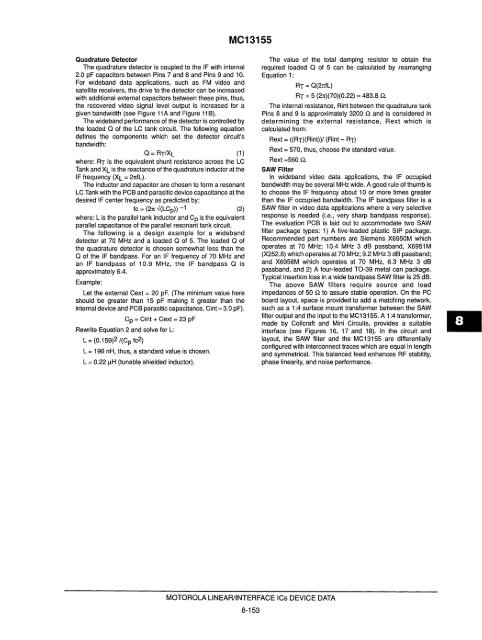Voltage References
Voltage References
Voltage References
You also want an ePaper? Increase the reach of your titles
YUMPU automatically turns print PDFs into web optimized ePapers that Google loves.
Quadrature Detector<br />
The quadrature detector is coupled to the IF with internal<br />
2.0 pF capacitors between Pins 7 and 8 and Pins 9 and 10.<br />
For wide band data applications, such as FM video and<br />
satellite receivers, the drive to the detector can be increased<br />
with additional external capacitors between these pins, thus,<br />
the recovered video signal level output is increased for a<br />
given bandwidth (see Figure 11 A and Figure 11 B).<br />
The wide band performance of the detector is controlled by<br />
the loaded Q of the LC tank circuit. The following equation<br />
defines the components which set the detector circuit's<br />
bandwidth:<br />
Q = RT/XL (1)<br />
where: RT is the equivalent shunt resistance across the LC<br />
Tank and XL is the reactance of the quadrature inductor at the<br />
IF frequency (XL = 21tfL).<br />
The inductor and capacitor are chosen to form a resonant<br />
LC Tank with the PCB and parasitic device capacitance at the<br />
desired I F center frequency as predicted by:<br />
fc = (21t --i(LCp)) -1 (2)<br />
where: L is the parallel tank inductor and Cp is the equivalent<br />
parallel capacitance of the parallel resonant tank circuit.<br />
The following is a design example for a wide band<br />
detector at 70 MHz and a loaded Q of 5. The loaded Q of<br />
the quadrature detector is chosen somewhat less than the<br />
Q of the IF bandpass. For an IF frequency of 70 MHz and<br />
an IF bandpass of 10.9 MHz, the IF bandpass Q is<br />
approximately 6.4.<br />
Example:<br />
Let the external Cext = 20 pF. (The minimum value here<br />
should be greater than 15 pF making it greater than the<br />
internal device and PCB parasitic capacitance, Cint = 3.0 pF).<br />
Cp = Cint + Cext = 23 pF<br />
Rewrite Equation 2 and solve for L:<br />
L = (0.159)2 /(Cp fc2)<br />
L = 198 nH, thus, a standard value is chosen.<br />
L = 0.22 IJ.H (tunable shielded inductor).<br />
MC13155<br />
The value of the total damping resistor to obtain the<br />
required loaded Q of 5 can be calculated by rearranging<br />
Equation 1:<br />
RT= Q(21tfL)<br />
RT = 5 (21t)(70)(0.22) = 483.8 Q.<br />
The internal resistance, Rint between the quadrature tank<br />
Pins 8 and 9 is approximately 3200 Q and is considered in<br />
determining the external resistance, Rext which is<br />
calculated from:<br />
Rext = ((RT)(Rint))/ (Rint - RT)<br />
Rext = 570, thus, choose the standard value.<br />
Rext =560 Q.<br />
MOTOROLA LINEAR/INTERFACE ICs DEVICE DATA<br />
8-153<br />
SAW Filter<br />
In wide band video data applications, the I F occupied<br />
bandwidth may be several MHz wide. A good rule of thumb is<br />
to choose the IF frequency about 10 or more times greater<br />
than the IF occupied bandwidth. The IF bandpass filter is a<br />
SAW filter in video data applications where a very selective<br />
response is needed (i.e., very sharp bandpass response).<br />
The evaluation PCB is laid out to accommodate two SAW<br />
filter package types: 1) A five-leaded plastic SIP package.<br />
Recommended part numbers are Siemens X6950M which<br />
operates at 70 MHz; 10.4 MHz 3 dB passband, X6951 M<br />
(X252.8) which operates at 70 MHz; 9.2 MHz 3 dB passband;<br />
and X6958M which operates at 70 MHz, 6.3 MHz 3 dB<br />
passband, and 2) A four-leaded TO-39 metal can package.<br />
Typical insertion loss in a wide bandpass SAW filter is 25 dB.<br />
The above SAW filters require source and load<br />
impedances of 50 Q to assure stable operation. On the PC<br />
board layout, space is provided to add a matching network,<br />
such as a 1:4 surface mount transformer between the SAW<br />
filter output and the input to the MC 13155. A 1 :4 transformer,<br />
made by Coilcraft and Mini Circuits, provides a suitable<br />
interface (see Figures 16, 17 and 18). In the circuit and<br />
layout, the SAW filter and the MC13155 are differentially<br />
configured with interconnect traces which are equal in length<br />
and symmetrical. This balanced feed enhances RF stability,<br />
phase linearity, and noise performance.

















